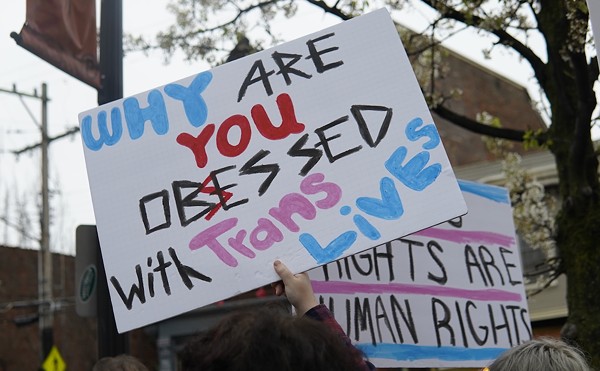|
If enough Cleveland Indians fans believed they were cursed by Chief Wahoo, they would call for the front office to retire this fatuous embarrassment, which mocks the club's foibles and dismisses Native Americans with the same cartoon flippancy. In more ways than one, curse or not, Chief Wahoo is a loser.
One wonders how the Indians and many of their fans are so slow to catch on. Hundreds of people and images have come and gone in 60 years since the Indians last won the World Series, but Chief Wahoo is the only survivor. Maybe he's telling them something.
Bobby Avila, Luke Easter, Early Wynn, Herb Score, Vic Wertz, Sam McDowell, Max Alvis, Albert Belle, Buddy Bell, Jay Bell, Joe Azcue, Al Lopez, Albie Lopez, Sandy Alomar, Alex Johnson, Alex Cole, Coco Crisp, Cris Chambliss, Chad Curtis, Curtis Wardle, Wayne Garland, Gaylord Perry, Jim Perry and many, many more have been there, done that and left since the Indians last won the World Series in 1948. But Chief Wahoo's smiling countenance has overseen it all, never to be called for account.
Perhaps a sneering silence is Chief Wahoo's crown, but if he could talk, what would he say? Is he smiling because he's happy? Is he happy because the Indians always flop in the end?
Is he an ironic joke on the ball club?
While Native American groups protest the Chief Wahoo characterization — a writer once said he looks like he's been drinking ripple from a paper bag — baseball fans know he equally characterizes failure on the field.
The Indians gave their chief more fodder last weekend, blowing a 3-1 series lead against the Boston Red Sox in the American League Championship Series and losing in seven games. Since the red-faced Chief Wahoo arrived in 1951, the Indians are the American League's most star-crossed franchise. The Washington Senators-Texas Rangers operation is actually worse, but not because it's unlucky.
In 1954, the Indians won 111 games in a 154-game season, but their .721 winning percentage, the highest of all time, couldn't prevent a four-game World Series sweep by the New York Giants. Over the next 40 years, the Indians managed only 11 winning seasons, and in four of those winners they were barely over .500.
Starting in 1995, the Indians won their division six of seven times. But they advanced to the World Series only twice, losing both times. In one of those classics, 1997, their home-crafted club lost the World Series to a five-year-old expansion team, the mercenary Florida Marlins.
Few arguments about any subject are weaker than the stock defenses for Chief Wahoo. The chief's defenders, being systematically confused, often point at references to white peoples in team nicknames as being somehow analogous. It's mean-spirited to question their sincerity but useful to mention that their views issue form a fundamental misunderstanding about American life.
Much discussion of race in America arises from blindness about class distinctions, which many people wish to deny. Lower class whites believe they are oppressed, and they are. But they believe they're oppressed because of favors and sensitivities extended to other races and ethnicities, as their messengers tell them, when they're really oppressed by the machinations of wealth, which their messengers don't tell them.
Anecdotally, at least, one surmises that white folks who don't share all the goodies available to white folks don't see ethnic stereotyping and oppression as a special problem. It's as if they might say, understandably, "Who isn't oppressed?"
And there is a certain defeatism in claiming oppression. When you define yourself by your oppression, your oppressor has won. In the case of Native Americans, however, the oppressor has won.
It remains easy to identify oppression against Native Americans and African Americans in the United States because of its brutal, demeaning mechanisms. It's less easy to spot the sources of oppression against poor whites, which are abstract, subtle and relatively bloodless.
The difference is that American Indians and African Americans didn't define themselves by their oppression. Their oppressors defined them as oppressed by oppressing them.
Chief Wahoo is just another brick in that wall, an unflattering characterization that reinforces Native America's impotence against the dominant culture. Chief Wahoo is in poor taste because he literally adds insult to injury. He's salt in the wound.
Whites don't like salt in their wounds, either. But well-resourced white groups can do something about it.
Back in 1997, the Stanford marching band played at a game against Notre Dame. The show, according to The San Francisco Chronicle, "parodied, among other things, the 19th-century Irish potato famine — which took more than 1 million lives — and portrayed a Catholic cardinal as an anti-intellectual advocate of flat-Earth and other unscientific theories."
Said Rev. Edward Malloy, the Notre Dame president at the time, "Such bigotry is absolutely unacceptable, especially from a student organization representing an institution that rightfully prides itself on diversity." Malloy added that the band's show and later statements by band members "indicate an ignorance of Irish history and indifference to human suffering in that country."
Stanford University issued three official apologies within 10 days, and the band still is indefinitely banned from playing at Notre Dame. The Irish-Catholic community is powerful enough to fight back.
But if the Stanford band had parodied the Illini at a game against the University of Illinois, who would take up that fight? It would be wrong, but we've already turned a deaf ear to the Illini.
The issue here is not the nickname "Indians," which is dicey and objectionable but not pejorative or harmful on its face. "Redskins" is another matter, a clear derogation in the same spirit as Chief Wahoo. The ball club in Cleveland would have you believe Chief Wahoo is not a derogation, but only if you misunderstand the dynamics of derogation.
Check out this remarkable quote recently from Cleveland Indians spokesman Bob DiBiasio in The Boston Globe: "We believe this is an issue of perception. We think people look at the logo and they think about baseball — they think about C.C. Sabathia, Bob Feller, Larry Doby and Omar Vizquel. The Wall Street Journal did an editorial about the Jeep Cherokee and concluded that something cannot be demeaned if there is no intent to demean."
Such a ham-fisted view of perception and intent this implies. It's as if people couldn't possibly see baseball and a cheap insult against Native Americans in the same logo. It's as if the fairly common experience of unintentionally offending someone were a human impossibility. It's as if we should take cues about social cohesion from The Wall Street Journal's editorial board, which advocates social cohesion only when free markets aren't in the way, if then.
It's as if Chief Wahoo were defensible, curse or no curse.





